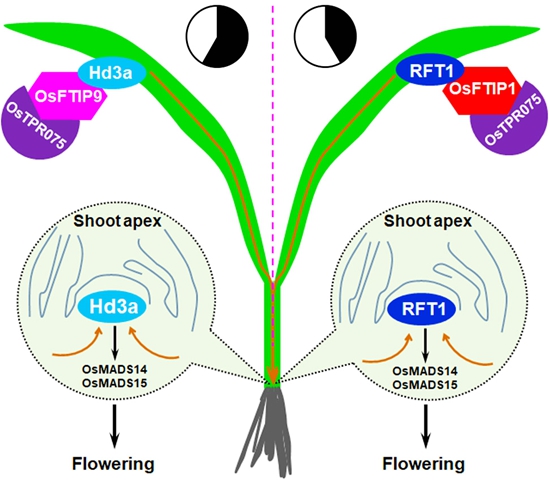Scientists Further Unravelled the Underlying Mechanism of Heading Date Control in Rice
Rice heading date (flowering time) marks the floral transition from the vegetative stage to the reproductive stage in rice. It is a vital agronomic trait that influences rice reproduction and an important target trait in breeding. Heading date control in rice is very complicated, involving both genetic factors and exogenous factors, such as photoperiod and temperature. Early-heading and late-heading influences grain filling during the grouting stage through the effect on photosynthate accumulation, resulting in impact on rice yield and quality. Moreover, heading date also determines regional adaptability and yield of rice. Therefore, study on the molecular regulation mechanism of heading date in rice is of crucial significance to molecular breeding and agricultural production both theoretically and in practice.
Recently, the Quality Rice Breeding Innovation Team from China National Rice Research Institute, Chinese Academy of Agricultural Sciences (CNRRI, CAAS), in collaboration with Zhejiang University and National University of Singapore, has revealed that the OsTPR075–OsFTIP1/9–RFT1/Hd3a module plays an important role in rice dating time regulation. The study entitled “The tetratricopeptide repeat protein OsTPR075 promotes heading by regulating florigen transport in rice” was published in Plant Cell.

Heading date 3a (Hd3a) and RICE FLOWERING LOCUS T1 (RFT1) are indispensable in promoting flowering of rice under short-day (SD) and long-day (LD) conditions respectively, which are synthesized in leaves and trafficked to the shoot apical meristem. FT-INTERACTING PROTEIN1 (OsFTIP1) is the only protein reported to mediate RFT1 transport in rice under LDs. Using gene editing technology, researchers generated Osftip9 mutants and observed that all alleles of Osftip9 displayed late heading under SDs. Moreover, researchers utilized immunoelectron microscopy in revealing that OsFTIP9 influences Hd3a export from companion cells to sieve elements, thus affecting rice heading date. Furthermore, researchers isolated OsTPR075, a tetratricopeptide repeat (TPR) protein of unknown function, and found that it interacts with both OsFTIP9 and OsFTIP1 and strengthens their respective interactions with Hd3a and the florigen RFT1. In a nutshell, their findings unravelled the ultimately important role of OsTPR075–OsFTIP1/9–RFT1/Hd3a module in regulating florigen transport in rice under SD and LD conditions, providing further clues for follow-up study of this module in other flowering plants, especially crops, so as to better understand and utilize the molecular mechanism of florigen transport and flowering time regulation.
This work was supported by the National Natural Science Foundation of China (32000213 and 32070209), Zhejiang Provincial Natural Science Foundation (LR21C130001 and LQ21C020003), Leading Innovative and Entrepreneur Team Introduction Program of Zhejiang (2019R01002), Key Research and Development Program of Zhejiang (2020C02002 and 2021C02063-1), and the Singapore National Research Foundation Investigatorship Program (NRF-NRFI2016-02).
Link to this paper: https://academic.oup.com/plcell/advance-article/doi/10.1093/plcell/koac190/6619169?searchresult=1
By Shen Huizhi (shenhuizhi@caas.cn)
-
 Apr 18, 2024Opening Ceremony of the Training Workshop on Wheat Head Scab Resistance Breeding and Pest Control in Africa Held in CAAS
Apr 18, 2024Opening Ceremony of the Training Workshop on Wheat Head Scab Resistance Breeding and Pest Control in Africa Held in CAAS -
 Apr 03, 2024IPPCAAS Co-organized the Training Workshop on Management and Application of Biopesticides in Nepal
Apr 03, 2024IPPCAAS Co-organized the Training Workshop on Management and Application of Biopesticides in Nepal -
 Mar 28, 2024Delegation from the School of Agriculture and Food Science of University College Dublin, Ireland Visit to IAS, CAAS
Mar 28, 2024Delegation from the School of Agriculture and Food Science of University College Dublin, Ireland Visit to IAS, CAAS -
 Mar 25, 2024Director of World Food Prize Foundation visited GSCAAS
Mar 25, 2024Director of World Food Prize Foundation visited GSCAAS -
 Mar 20, 2024Institute of Crop Sciences (ICS) and Syngenta Group Global Seeds Advance Collaborative Research in the Seed Industry
Mar 20, 2024Institute of Crop Sciences (ICS) and Syngenta Group Global Seeds Advance Collaborative Research in the Seed Industry
